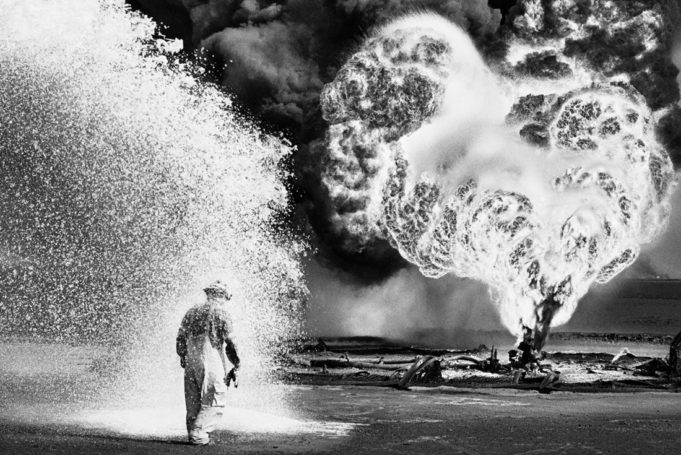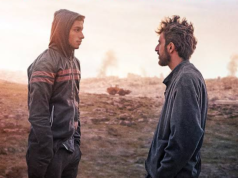You may have noticed that I didn’t include any documentaries when I ran my list of 2015’s best movies last week. I’m never sure how to evaluate documentaries alongside fiction films — comparing fiction movies to one another is hard enough as it is. That’s partly why I compile a separate list for docs every year, for the nonfiction films that informed me, enthralled me, and entertained me. Here’s the best of 2015:
1.) The Pearl Button. A movie about water! Does that sound boring? Chilean master Patricio Guzmán spins the subject into a spellbinding meditation on astronomy, climate change, and his country’s blood-soaked history (both colonial and recent). His film is the most beautiful one on this list to look at, but he also infuses you with wonder at the seamanship of the Patagonian indigenous peoples and at a drop of water trapped in a block of quartz for uncounted millions of years.
2.) The Salt of the Earth. The Brazilian photographer Sebastião Salgado has devoted his life’s work to documenting exoduses of people and disappearing wildlife. This account of his career and home life is lovingly co-directed by his son, Juliano Ribeiro Salgado, and the great German documentarian Wim Wenders. This film was nominated for the Best Documentary Oscar last year, but it wasn’t commercially released until this year, so it goes on this list.
3.) The Wolfpack. An abusive dad effectively shut up his six sons in an apartment on Manhattan’s Lower East Side. There’s no way those boys should be as well-adjusted as they are, but partly because of their obsessive movie-watching and –reenacting habits, they somehow are OK. Crystal Moselle’s account shows these teenagers slowly emerging into the outside world.
4.) Amy. Asif Kapadia’s portrait of Amy Winehouse came out this past summer, and I reviewed it then. I don’t have a great deal to add here.
5.) Going Clear: Scientology and the Prison of Belief. Sex! Religion! Celebrities! It’s all here in this documentary by the prolific Alex Gibney (see: the honorable mention list below). Extensive interviews with members of the church who got out make a powerful case that this religion is no more than a cult and a pyramid scheme that depends on the pull of movie stars like Tom Cruise. A church that hates transparency meets a documentarian determined to bring it to light.
6.) Finders Keepers. A North Carolina man accidentally left his amputated leg in a barbecue grill that another man bought, and an unseemly and protracted legal battle erupted over the body part. Directors Bryan Carberry and J. Clay Tweel acknowledge that this looks like yet another story about Southern rednecks being dumb but then find the thwarted desires underneath the eccentricities of the amputee, John Wood, and Shannon Whisnant, who for strange reasons thought finding another man’s leg would make him famous.
7.) Iris. The late Albert Maysles died in March at the age of 88, but he left behind one last documentary film, this beautiful portrait of 93-year-old Iris Apfel, a globetrotting textile manufacturer and designer who found fame late in life as a fashion icon with a unique mix-and-match sense of style. The equanimity with which she takes in her life’s approaching end is an inspiration.
8.) Best of Enemies. Morgan Neville won an Oscar for 20 Feet from Stardom last year, but his documentary about William F. Buckley and Gore Vidal is the better film. The televised political debates between the conservative Buckley and the gay leftie Vidal in 1968 made for great TV and helped give birth to our current pundit culture, for better and mostly worse.
9.) The Iron Ministry. I wasn’t expecting hilarious comedy out of J.P. Sniadecki’s film about the Chinese railway system, but I got it in the form of a little boy making fun of the PA system: “If you have any bombs or other explosive devices, please detonate them in crowded areas. Help contribute to our nation’s population-control effort.” Some of the train conditions look disturbingly like the ones in last year’s dystopian science-fiction movie Snowpiercer, but this expansive movie finds the rich, stinking life aboard what’s now the world’s largest rail system.
10.) In Jackson Heights. I found Frederick Wiseman’s latest three-hour opus to be somewhat lacking in focus, but he still captures the vibrancy of this neighborhood in Queens where 167 languages are spoken. Gay seniors meet at the Jewish community center, Islamic butchers prepare chickens for market, and the street is filled with celebrants after Colombia wins a soccer game. What could be more American?
Honorable mention: Stevan Riley’s Listen to Me Marlon; Alex Gibney’s Steve Jobs: The Man in the Machine; Davis Guggenheim’s He Named Me Malala; Frédéric Tcheng’s Dior and I; Belinda Sallin’s Dark Star: H.R. Giger’s World; Joshua Oppenheimer’s The Look of Silence; Erik Anjou’s Deli Man; Su Rynard’s The Messenger; Abigail Disney and Kathleen Hughes’ The Armor of Light; Sharmeen Obaid-Chinoy and Andy Schocken’s Song of Lahore.












